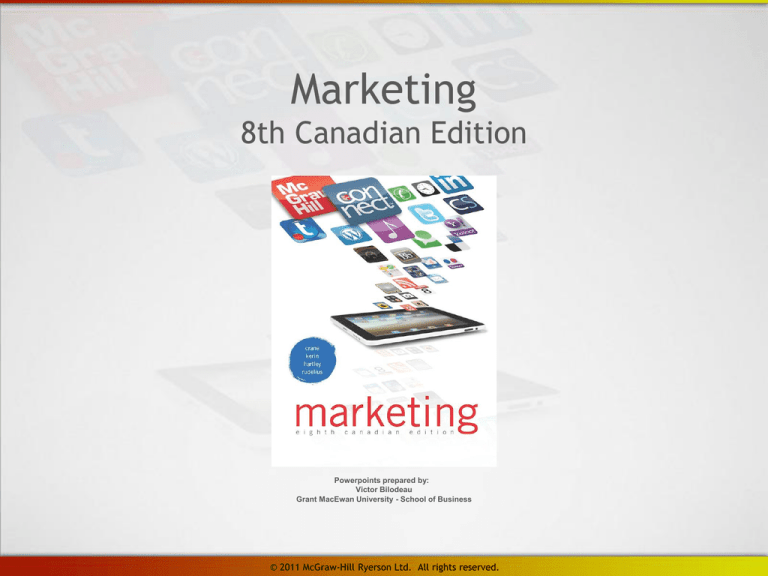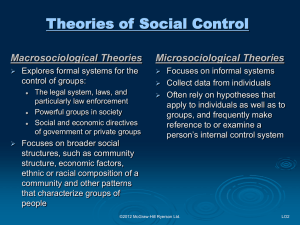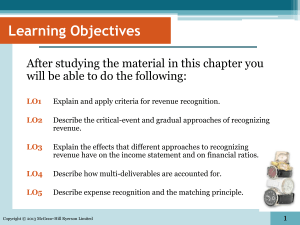
Marketing
8th Canadian Edition
Powerpoints prepared by:
Victor Bilodeau
Grant MacEwan University - School of Business
© 2011 McGraw-Hill Ryerson Ltd. All rights reserved.
Developing Successful
Marketing Strategies
© 2011 McGraw-Hill Ryerson Ltd. All rights reserved.
Learning Objectives
After reading this chapter, you should be able to:
1.Describe the kinds of organization that exist and the three levels
of strategy in them.
2.Describe how core value, mission, organizational culture,
business, and goals are important in organizations.
3.Explain how organizations set strategic directions and tracks
performance by using marketing dashboards and metrics.
4.Describe the strategic marketing process and its three key
phases: planning, implementation, and evaluation.
5.Explain how the marketing mix elements are blended into a
cohesive marketing program.
© 2011 McGraw-Hill Ryerson Ltd. All rights reserved.
DEVELOPING SUCCESSFUL MARKETING
STRATEGIES
‣ Canadian Tire: The
Creation and Growth of a
Visionary Organization
‣ Canadian company
‣ Founded in 1927
‣ Current Revenue of more
than $11 Billion Annually
‣ More than 57,000 employees
© 2011 McGraw-Hill Ryerson Ltd. All rights reserved.
DEVELOPING SUCCESSFUL MARKETING
STRATEGIES
‣ Today’s Organizations
‣ Kinds of Organization
‣ Business firms
‣ Non-profit organizations
‣ What is Strategy?
‣ Structure of Today’s Organization
‣ Corporate level
‣ Strategic Business unit level
‣ Functional level
© 2011 McGraw-Hill Ryerson Ltd. All rights reserved.
LO 1
FIGURE 2-1 The board of directors oversees the three
levels of strategy in organizations: corporate, business unit,
and functional
© 2011 McGraw-Hill Ryerson Ltd. All rights reserved.
LO 1
Learning Review
What is the difference between a business firm and a non-profit
organization?
Answer:
A nonprofit organization is a nongovernmental organization that
serves its customers but does not have profit as an organizational
goal.
A business firm is a privately owned organization that serves its
customers in order to earn a profit.
© 2011 McGraw-Hill Ryerson Ltd. All rights reserved.
LO 1
Learning Review
What is strategy?
Answer:
An organization’s long-term course of action designed to deliver
a unique customer experience while achieving its goals.
© 2011 McGraw-Hill Ryerson Ltd. All rights reserved.
LO 1
Learning Review
What are examples of a functional level in an organization?
Answer:
The marketing department or information systems department
are examples of functional levels in an organization.
© 2011 McGraw-Hill Ryerson Ltd. All rights reserved.
LO 1
STRATEGY IN VISIONARY ORGANIZATIONS
‣ Organizational Foundation: Why does it exist?
‣ Core Values
‣ Mission
‣ Organizational Culture
© 2011 McGraw-Hill Ryerson Ltd. All rights reserved.
LO 2
FIGURE 2-2 Today’s visionary organization uses key
elements to (1) establish a foundation and (2) set a
direction using (3) its strategies that enable it to develop
and market its offerings successfully
© 2011 McGraw-Hill Ryerson Ltd. All rights reserved.
LO 2
STRATEGY IN VISIONARY ORGANIZATIONS
‣ Organizational Direction: What will it do?
‣ Business
‣ Goals
‣
‣
‣
‣
‣
‣
‣
‣
Profit
Sales revenue
Market share
Unit sales
Quality
Customer satisfaction
Employee welfare
Social responsibility
© 2011 McGraw-Hill Ryerson Ltd. All rights reserved.
LO 2
In the first half of the
20th century, what
“business” did
railroads believe they
were in? The text
reveals their
disastrous error.
© 2011 McGraw-Hill Ryerson Ltd. All rights reserved.
LO 2
STRATEGY IN VISIONARY ORGANIZATIONS
‣ Organizational Strategies: How will it do?
‣ Variation by Level
‣ Variation by Offering
© 2011 McGraw-Hill Ryerson Ltd. All rights reserved.
LO 2
Learning Review
What is the meaning of an organization’s mission?
Answer:
It is a statement of the organization’s function in society.
© 2011 McGraw-Hill Ryerson Ltd. All rights reserved.
LO 2
Learning Review
What is the difference between an organization’s “business” and
its “goals”?
Answer:
A business describes the clear, broad, underlying industry or
market sector of an organization’s offering.
Goals are statements of an accomplishment of a task to be
achieved, often by a specific time.
© 2011 McGraw-Hill Ryerson Ltd. All rights reserved.
LO 2
SETTING STRATEGIC DIRECTIONS
‣ A Look Around: Where Are We Now?
‣ Competencies
‣ Competitive advantage
‣ Quality
‣ Benchmarking
‣ Customers
‣ Competitors
© 2011 McGraw-Hill Ryerson Ltd. All rights reserved.
LO 3
SETTING STRATEGIC DIRECTIONS
‣ Growth Strategies: Where Do We Want to Go?
‣ Business Portfolio Analysis
‣ BCG Analysis
© 2011 McGraw-Hill Ryerson Ltd. All rights reserved.
LO 3
FIGURE 2-3 Boston Consulting Group portfolio analysis.
© 2011 McGraw-Hill Ryerson Ltd. All rights reserved.
LO 3
SETTING STRATEGIC DIRECTION
‣ Growth Strategies: Where Do We Want to Go? (cont.)
‣ Market-Product Analysis
© 2011 McGraw-Hill Ryerson Ltd. All rights reserved.
LO 3
FIGURE 2-4 Four market-product strategies
© 2011 McGraw-Hill Ryerson Ltd. All rights reserved.
LO 3
A campaign to
promote increased
milk consumption in
Québec is an example
of the market
penetration
marketing strategy
© 2011 McGraw-Hill Ryerson Ltd. All rights reserved.
LO 3
The product
development
marketing strategy
involves selling new
products to
existing markets, as
Coca-Cola did when
introducing a new line
of chai tea.
© 2011 McGraw-Hill Ryerson Ltd. All rights reserved.
LO 3
SETTING STRATEGIC DIRECTION
‣ Tracking Strategic Performance with Marketing
Dashboards and Metrics
‣ Car Dashboards and Marketing Dashboards
‣ Marketing Dashboard
‣ Marketing Metric
‣ Marketing Plan
© 2011 McGraw-Hill Ryerson Ltd. All rights reserved.
LO 3
An effective
marketing dashboard,
like this one for
Oracle, helps
managers assess a
business
situation at a glance.
© 2011 McGraw-Hill Ryerson Ltd. All rights reserved.
LO 3
Using Marketing
Dashboards
Which Provinces Are
Underperforming?
© 2011 McGraw-Hill Ryerson Ltd. All rights reserved.
LO 3
Learning Review
What is a business portfolio analysis?
Answer:
Business portfolio analysis is the understanding of a firm's
strategic business units (SBU's) as though they were a collection
of separate investments.
© 2011 McGraw-Hill Ryerson Ltd. All rights reserved.
LO 3
Learning Review
What are the four market-product strategies?
Answer:
The four market-product strategies are:
•
Market penetration
•
Product development
•
Market development
•
Diversification
© 2011 McGraw-Hill Ryerson Ltd. All rights reserved.
LO 3
Learning Review
What is a marketing dashboard?
Answer:
The visual computer display of the essential information related
to achieving a marketing objective.
© 2011 McGraw-Hill Ryerson Ltd. All rights reserved.
LO 3
THE STRATEGIC
MARKETING PROCESS
‣ Strategic Marketing Process: The Planning Phase
‣ Step 1: Situation (SWOT) Analysis
‣ SWOT analysis
‣ Step 2: Market-Product Focus and Goal Setting
‣
‣
‣
‣
Set marketing and product goals
Select target markets
Find points of difference
Position the product
‣ Step 3: Marketing Program
‣ Product, Price, Promotion & Place (distribution) strategies
© 2011 McGraw-Hill Ryerson Ltd. All rights reserved.
LO 4, 5
FIGURE 2-5 The strategic marketing process
© 2011 McGraw-Hill Ryerson Ltd. All rights reserved.
LO 4
FIGURE 2-6 Ben & Jerry’s: a SWOT analysis to get it
growing again in Canada
© 2011 McGraw-Hill Ryerson Ltd. All rights reserved.
LO 4
FIGURE 2-7 Elements of the marketing
mix that comprise a cohesive marketing program
© 2011 McGraw-Hill Ryerson Ltd. All rights reserved.
LO 4, 5
Learning Review
What is the difference between a strength and an opportunity in
a SWOT analysis?
Answer:
In a SWOT analysis, a strength is a favourable evaluation of the
internal situation at the level of the entire organization, the
business unit, the product line, or the specific product. An
opportunity is a favourable evaluation of the external situation
at the level of the entire organization, the business unit, the
product line, or the specific product.
© 2011 McGraw-Hill Ryerson Ltd. All rights reserved.
LO 4, 5
Learning Review
What is market segmentation?
Answer:
Market segmentation is the process of aggregating prospective
buyers into groups, or segments, that (1) have common needs
and (2) will respond similarly to a marketing action.
© 2011 McGraw-Hill Ryerson Ltd. All rights reserved.
LO 4, 5
Learning Review
What are “points of difference” and why are they important?
Answer:
Points of difference are those characteristics of a product that
make it superior to competitive substitutes. This concept is the
single most important factor in the success or failure of a new
product.
© 2011 McGraw-Hill Ryerson Ltd. All rights reserved.
LO 4, 5
THE STRATEGIC
MARKETING PROCESS
‣ Strategic Marketing Process: The Implementation
Phase
‣ Obtaining Resources
‣ Designing the Marketing Organization
‣ Developing Schedules
‣ Executing the Marketing Program
‣ Marketing strategy
‣ Marketing tactics
© 2011 McGraw-Hill Ryerson Ltd. All rights reserved.
LO 5
FIGURE 2-8 Organization of a typical manufacturing firm
showing a breakdown of the marketing department
© 2011 McGraw-Hill Ryerson Ltd. All rights reserved.
LO 5
3 Musketeers has a
specific target market
and a specific
marketing program to
reach it
© 2011 McGraw-Hill Ryerson Ltd. All rights reserved.
LO 5
THE STRATEGIC
MARKETING PROCESS
‣ Strategic Marketing Process: The Evaluation Phase
‣ Comparing Results with Plans to Identify Deviations
‣ Correcting a negative deviation
‣ Exploiting a positive deviation
© 2011 McGraw-Hill Ryerson Ltd. All rights reserved.
LO 5
Learning Review
What is the evaluation phase of the strategic management
process?
Answer:
The evaluation phase of the strategic marketing process seeks to
keep the marketing program moving in the direction set for it.
© 2011 McGraw-Hill Ryerson Ltd. All rights reserved.
LO 5
Learning Review
How do the objectives set for a marketing process in the
planning phase relate to the evaluation phase of the strategic
marketing process?
Answer:
In the evaluation phase, the marketing manager (1) compare the
results of the marketing program with the goals in the written
plans to identify deviations and (2) to act on these deviations-correcting negative deviations and exploiting positive ones.
© 2011 McGraw-Hill Ryerson Ltd. All rights reserved.
LO 5
VIDEO CASE 2
Canadian Tire
Canadian Tire
© 2011 McGraw-Hill Ryerson Ltd. All rights reserved.
VIDEO CASE 2-1
Canadian Tire
Canadian Tire has articulated three strategic
goals/objectives (see above). Do you agree with these
goals/objectives? If so, how best can they be achieved?
If you do not agree, what should be the company’s
strategic objectives?
© 2011 McGraw-Hill Ryerson Ltd. All rights reserved.
VIDEO CASE 2-2
Canadian Tire
You learned in this chapter that part of determining
growth strategies is determining where the company
wants to go. Using the market-product analysis (see
Figure 2-4) map out the growth strategies for each of
Canadian Tire’s business units?
© 2011 McGraw-Hill Ryerson Ltd. All rights reserved.
VIDEO CASE 2-3
Canadian Tire
Another thing you learned in this chapter is the
importance of tracking performance by using marketing
dashboards and metrics. Take a look at Figure 2 in the
case. What can you glean from this data in terms of the
performance of each business unit?
© 2011 McGraw-Hill Ryerson Ltd. All rights reserved.
VIDEO CASE 2-4
Canadian Tire
Now, again, look at the data in Figure 2, calculate the
rate of return (percentage-wise) that each business unit
is contributing to earnings before taxes for each
business unit. What does this reveal? Does this impact
on your decision about where to grow the business?
Does this data affirm Canadian Tire’s belief that CTR is
and should be its “core business.”?
© 2011 McGraw-Hill Ryerson Ltd. All rights reserved.
VIDEO CASE 2-5
Canadian Tire
Canadian Tire is known for having the first and mostenduring loyalty programs in Canada – Canadian Tire
Money. How can the company leverage this program to
achieve additional market growth?
© 2011 McGraw-Hill Ryerson Ltd. All rights reserved.
Profit
‣ The reward to a business firm for the risk it
undertakes in offering a product for sale; the money
left over after a firm’s total expenses are subtracted
from its total revenues.
© 2011 McGraw-Hill Ryerson Ltd. All rights reserved.
Corporate level
‣ The corporate level is where top management directs
overall strategy for the entire organization.
© 2011 McGraw-Hill Ryerson Ltd. All rights reserved.
Functional Level
‣ The functional level is where groups of specialists
actually create value for the organization.
© 2011 McGraw-Hill Ryerson Ltd. All rights reserved.
Cross-Functional Teams
‣ Cross-functional teams include a small number of
people from different departments in an organization
who are mutually accountable to a common set of
performance goals.
© 2011 McGraw-Hill Ryerson Ltd. All rights reserved.
Mission
‣ A mission is a statement of the organization’s scope.
© 2011 McGraw-Hill Ryerson Ltd. All rights reserved.
Goals
‣ Goals or objectives convert the mission into targeted
levels of performance to be achieved.
© 2011 McGraw-Hill Ryerson Ltd. All rights reserved.
Market Share
‣ Market share is the ratio of sales revenue of the firm
to the total sales revenue of all firms in the industry.
© 2011 McGraw-Hill Ryerson Ltd. All rights reserved.
Competencies
‣ Competencies are an organization’s special
capabilities, including skills, technologies, and
resources.
© 2011 McGraw-Hill Ryerson Ltd. All rights reserved.
Competitive Advantage
‣ A competitive advantage is a unique strength relative
to competitors.
© 2011 McGraw-Hill Ryerson Ltd. All rights reserved.
Quality
‣ Quality means the features and characteristics of a
product that influence its ability to satisfy customer
needs.
© 2011 McGraw-Hill Ryerson Ltd. All rights reserved.
Benchmarking
‣ Benchmarking is discovering how others do something
better than your own firm so you can imitate or
leapfrog competition.
© 2011 McGraw-Hill Ryerson Ltd. All rights reserved.
Strategic Marketing Process
‣ The strategic marketing process is how an
organization allocates its marketing mix resources to
reach its target markets.
© 2011 McGraw-Hill Ryerson Ltd. All rights reserved.
Marketing Plan
‣ A road map for the marketing activities of an
organization for a specified future period of time,
such as one year or five years.
© 2011 McGraw-Hill Ryerson Ltd. All rights reserved.
Situation Analysis
‣ Taking stock of where the firm or product has been
recently, where it is now, and where it is headed in
terms of the organization’s plans and the external
factors and trends affecting it.
© 2011 McGraw-Hill Ryerson Ltd. All rights reserved.
SWOT Analysis
‣ An acronym describing an organization’s appraisal of
its internal Strengths and Weaknesses and its external
Opportunities and Threats.
© 2011 McGraw-Hill Ryerson Ltd. All rights reserved.
Market Segmentation
‣ Market segmentation is the process of aggregating
prospective buyers into groups that have common
needs and will respond similarly to a marketing
action.
© 2011 McGraw-Hill Ryerson Ltd. All rights reserved.
Points of Difference
‣ Points of difference are those characteristics of a
product that make it superior to competitive
substitutes.
© 2011 McGraw-Hill Ryerson Ltd. All rights reserved.
Marketing Strategy
‣ A marketing strategy is the means by which a
marketing goal is to be achieved.
© 2011 McGraw-Hill Ryerson Ltd. All rights reserved.
Marketing Tactics
‣ Marketing tactics are detailed day-to-day operational
decisions essential to the overall success of marketing
strategies.
© 2011 McGraw-Hill Ryerson Ltd. All rights reserved.
Objectives
‣ Convert the mission into targeted levels of
performance to be achieved.
© 2011 McGraw-Hill Ryerson Ltd. All rights reserved.
Organizational Culture
‣ A set of values, ideas, and attitudes that is learned
and shared among the members of an organization.
© 2011 McGraw-Hill Ryerson Ltd. All rights reserved.
Business
‣ The clear, broad, underlying industry or market sector
of an organization’s offering.
© 2011 McGraw-Hill Ryerson Ltd. All rights reserved.
Core Values
‣ An organization’s core values are the fundamental,
passionate, and enduring principles that guide its
conduct over time.
© 2011 McGraw-Hill Ryerson Ltd. All rights reserved.
Marketing Dashboard
‣ The visual computer display of the essential
information related to achieving a marketing
objective.
© 2011 McGraw-Hill Ryerson Ltd. All rights reserved.
Marketing Metric
‣ A measure of the quantitative value or trend of a
marketing activity or result.
© 2011 McGraw-Hill Ryerson Ltd. All rights reserved.
Strategic Business Unit (SBU)
‣ A subsidiary, division, or unit of an organization that
markets a set of related offerings to a clearly defined
group of customers.
© 2011 McGraw-Hill Ryerson Ltd. All rights reserved.
Strategic Business Unit Level
‣ At the strategic business unit level, managers set a
more specific strategic direction for their businesses
to exploit value-creating opportunities. For less
complex firms with a single business focus, the
corporate and business unit levels may merge.
© 2011 McGraw-Hill Ryerson Ltd. All rights reserved.
Strategy
‣ An organization’s long-term course of action designed
to deliver a unique customer experience while
achieving its goals.
© 2011 McGraw-Hill Ryerson Ltd. All rights reserved.






